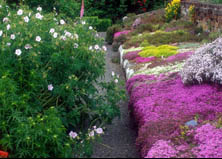Poyntzfield Herb Nursery, Echinacea and butterflies

In my last post I wrote about the wonderful chives that originated at Poyntzfield Herb Nursery on the Black Isle not far from Inverness, and last week I was up there for a visit. This picture shows the garden in late summer glory with a mass of soapwort in the foreground. This useful but highly spreading herb can be used to make a mild cleanser, just the thing for fabrics that have been dyed with herbal dyestuffs. But remember it is almost worse than mint for being invasive! No wonder it easily spread from the laundries in America when it had been taken there by settlers for the washtubs.
I sat in the garden in glorious sunshine having a cup of purple sage tea with Duncan Ross who has run Poyntzfield for many years and built it up to have a huge catalogue of herbs available by post. Seeds were drying in boxes in a lean-to shed ready for next year's plants, labels were all stacked neatly in alphabetical order. 
What amazed me in particular were the vast numbers of butterflies on all the plants -especially on the echinaceas, compact marjorams and this lovely Carline thistle. In common with reports I've heard from all over the country when visitors have come to Chesters Walled Garden, there has been a desperate drop in the butterfly population presumably due to the wet summer and Duncan said that their numbers were only up now in September - but it was a glorious sight, all the more so for being unusual this year.


1 comment:
Scotland has not had anything like the rain that we have had in England this year. During the early summer when we were having far more than 100% of our average rainfall the north of Scotland was actually having less than its average. Maybe English butterflies have migratd north for a bit of decent weather. Poyntzfield looks lovely. I must make a visit sometime.
I had an interesting botanical trip to Scotland myself. I went to see an area on and near Ben Lawers where the NTS is restoring plant habitats desperately damaged by serious overgrazing. A little of the cash for this big long-term project was raised by myself and some friends in memory of a good friend who was an outstanding botanist. It was good to see that the restoration work was going well. I also visited a garden on Speyside being run by one man who had a huge variety of both native and introduced plants covering a very wide area. I rarely visit Scotland without lighting upon some botanical gem.
Post a Comment